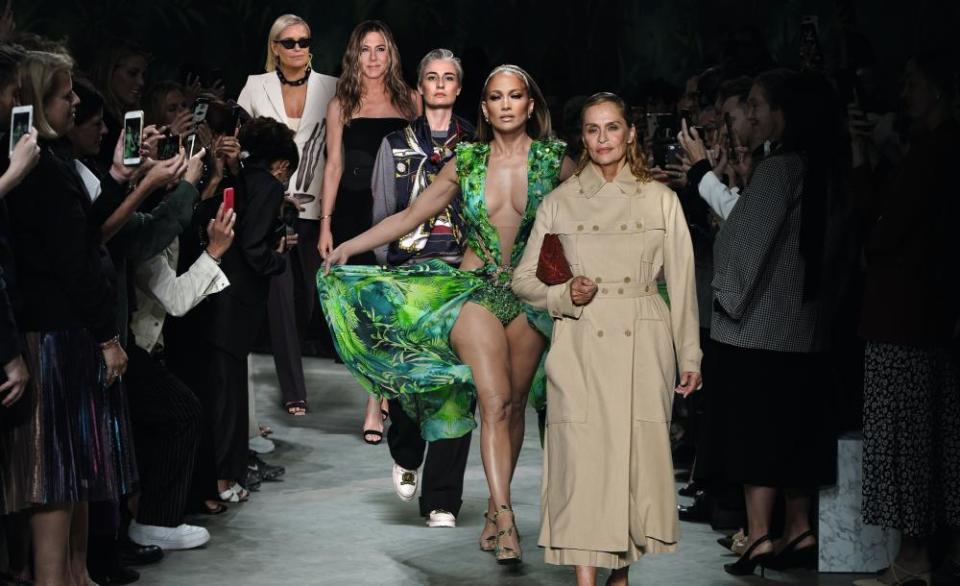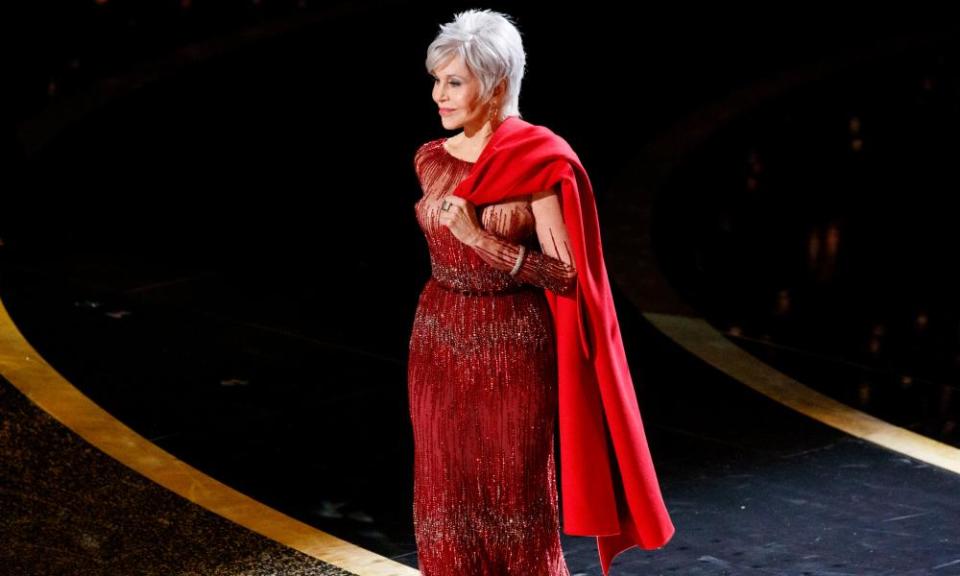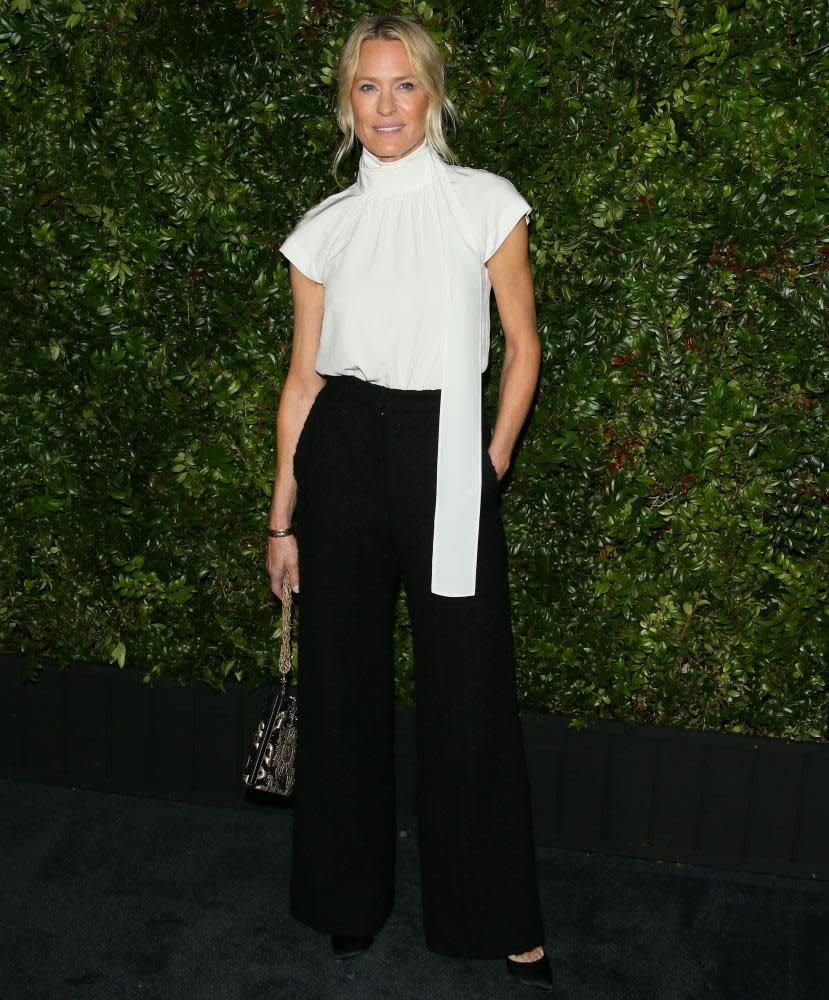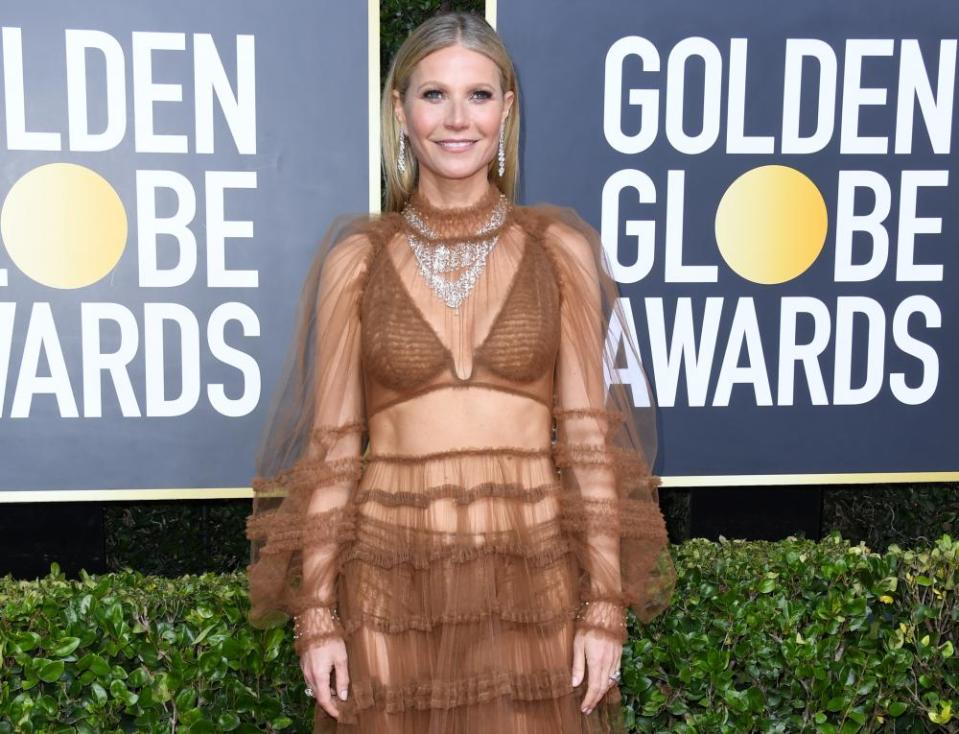Shades of 50: how the midlife woman went from invisible to the main event

At the end of the Versace show in Milan last September, Jennifer Lopez burst on to the catwalk in a blaze of glory. Chin proud, shoulders back, her vibe was somewhere between a bride making her church entrance and a cowboy kicking open the doors of a saloon bar. Split to the waist, the panels of her jungle-green dress floated on her slipstream as she sailed through the firefly cloud of camera phones. Her dress, with its navel-deep plunge, was That Dress – the one she had worn to the Grammys two decades earlier, the one that famously inspired the creation of Google Images. A pop culture goddess was reincarnated, shortly after her 50th birthday, and I whooped and clapped and joined in the confetti shower of fire emoji and heart-eyes raining down around me.
I am four years younger than Lopez. I harbour no catwalk ambitions whatsoever – the thought of that is making me chuckle gently to myself in my low-key, middle-aged way as I write – but I felt something joyous in Lopez owning that runway. Along with every other forty- or fiftysomething woman watching, in the room or on Instagram, it felt that I was in some way cheering for my team.
Cultural underdogs since for ever, midlife women are suddenly scene-stealers. At Paris fashion week last month, Helena Christensen (51) starred in the Balmain show, while Yolanda Hadid (56) joined her daughters Bella and Gigi on the catwalk at Off-White. When Jennifer Aniston appeared on the cover of Interview magazine for her 51st birthday, it was her bottom-half pairing of over-the-knee Celine leather boots and Alaïa knickers that made headlines, rather than anything she said. Last month, Lopez joined forces with Shakira – a mere baby at 43 – for a Super Bowl performance that ripped up the rulebook about what an on-stage duet looks like at their age. Instead of matronly gowns, sturdy chignons and stately ballad-singing, think peephole leathers and choreography involving poles and hair-whips.

Until now, 50 equalled invisible. The facts of real life – such as the findings of a report by Prof Lynda Gratton for the Longevity Forum two years ago, which found that age discrimination in the workplace began at 40 for women and 45 for men – have long been embedded in our culture. A diversity study for the University of Southern California found that, of films released in 2014, only 21.4% of characters over 40 were female. In 2015, a then 38-year-old Liv Tyler remarked that “when you’re in your teens or 20s, there is an abundance of ingenue parts which are exciting to play. But at my age, you’re usually the wife or the girlfriend – a sort of second-class citizen.” In 2011, the 40-year-old actor Junie Hoang brought a lawsuit against IMDb for revealing her age, alleging that this had cost her work in an industry in which “youth is king”.
There are structural reasons why the sands are shifting. As life expectancy increases, the meta-timetable that governs our lives requires redrafting. We are getting married later, having children later, so it is logical we tip into middle age later. No point rushing through life’s journeys and then twiddling your thumbs at the departure gate, as it were. There are practical reasons, too, why a swelling older population should stay fit and productive. Generations Y and Z have enough on their plates without being expected to foot the bill for half-centuries of feet-up retirement.
50 is all about smooth skin, taut abs, being able to wear the same revealing dress you wore two decades earlier
But this is not just about 50 being the new 40, an extra decade of (relative) youth tacked on to our lives like a side-return extension. When Gloria Steinem fired off her famous riposte, telling an interviewer who complimented her on not looking her age that “this is what 40 looks like”, it seemed then that the way she looked was a reflection of her spirit. Steinem was talking about how she carried herself, her body language, the clothes she wore, her choice of hairstyle – not just her skin texture or jean size. Meanwhile the modern rebranding of 50 is really all about the visual element: the smooth skin, taut abs, being able to wear the same revealing dress you wore two decades earlier.
Which is why, somewhere between J-Lo’s Versace plunge and Aniston’s Alaïa knickers, I started to wonder. Was I falling a teeny bit out of love with midlife’s new look? There are only so many times you can hear the word “empowering” used about somebody’s abs before it starts to niggle. What’s more, I can’t help noticing that the world has begun championing midlife women at the precise moment when advances in cosmetic surgery, skincare science and “tweakments”, alongside a boom in the diet and fitness industries, means that it is possible – with enough money, and knowhow, and leisure time – to spend your way out of the visible ageing process, the same way you could once spend your way to having a Hermès Birkin. Call me an old cynic, but I’m not sure that this is entirely a coincidence.

The fashion industry has been central to this rebranding of midlife. Donatella Versace has been the silent partner in Lopez’s half-century renaissance: remaking the iconic dress, casting her in September’s Versace show, creating a bespoke layered wardrobe for her Super Bowl performance. For the Interview magazine shoot, Aniston wore a bra top – and not just any bra top, but the Givenchy pink satin number worn in the catwalk show by Kaia Gerber, the 18-year-old supermodel daughter of Cindy Crawford. At the Golden Globes in January, Gwyneth Paltrow, 47, wore a Fendi dress the density of a single sheet of tissue paper, the herringbone lines of her external oblique muscles clearly visible on either side of her torso.
A new, aspirational version of midlife is a powerful marketing tool to win a lucrative customer base of older women with money to spend on becoming the best versions of themselves – whatever that means. Long gone are the days when a cameo by an ex-supermodel was a novelty at fashion week: these days, the catwalks are packed with more lithe fortysomethings than a £25 north London yoga class. When Meryl Streep was featured on the cover of Vogue, aged 62, in 2011, she was the oldest woman to do so; that record has since been broken several times, most recently by Lauren Hutton, who was nearly 74 when she made the cover of Vogue Italia in 2017. In 2012, a New York Times article about the rise of the older model quoted a casting agent who dismissed it as “just a fad”, but this has been proved wrong. The “sophisticated” division of Wilhelmina Models in New York, a spokeswoman recently told the LA Times, is the company’s fastest growing area.
The omerta around cosmetic surgery, and to a lesser degree Botox and fillers – or “sprinkles” as the latter two are known on the front row – cannot disguise the fact that the faces of many prominent midlifers are strikingly unlined and gravity-defying. The only person worth quoting on the topic, in my view, is 53-year-old actor Robin Wright, who, when asked whether she had tried Botox, told an interviewer, “You bet. Everybody fucking does it! I suppose I can’t say ‘everybody’ because I don’t know for sure, but come on!”
Interestingly, while any lines deeper than the lightest etching of crow’s feet have been all but eliminated from public-facing midlife, silver hair has come into vogue. Finally, the silver fox has gone gender neutral. Sharon Osbourne recently swapped her trademark crimson for an elegant Miranda Priestly platinum. Erin O’Connor walked the Tommy Hilfiger show at London fashion week with her once-raven hair now salt-and-pepper. Kim Kardashian, Ariana Grande, Lady Gaga, Zosia Mamet and Cara Delevingne have all experimented with silver.

In other words, this is not as simple as letting your roots grow out. Cheering though it is to see silver hair celebrated, note that it is sleek and salon-glossed, not flecked or wiry. (Jack Martin, the colourist who created Osborne’s new look, and who was responsible for 82-year-old Jane Fonda debuting her silver hair at this year’s Oscars, has become the silver-fox guru, booked solid for months.) As with so many aspects of the new-look midlife, this kind of silver hair requires a considerable outlay of time and money, and a rigorous schedule of upkeep. This is all part of the package: a disciplined routine of 10-step beauty regimes, daily workouts and rolling beauty appointments. It’s enough to make you pine for the prospect of being allowed to let yourself go.
Related: What not to wear if you are a man over 50
But optics are always about more than appearance. In my more churlish moods, the rebranding of midlife grates as a cheap trick to convince women to spend even more of our lives obsessing over our thighs. And that ageing is an embarrassing problem, one we can solve by throwing money at it. And still, there is a deep and true joy to be felt in a Lopez or Aniston showing what 50 can look like – because in our visually oriented culture, what 50 looks like is a statement about what 50 can be: relevant, fabulous, top-of-your-game. As the silver-haired, sexagenarian swimsuit model Yazemeenah Rossi told the Observer: “I may be a certain age, but I have a sexy look. Sexy means alive. I’m alive!”
The new-look midlife goddess is a powerful totem. I will bow down in worship, even if I don’t entirely believe in it.
• If you would like your comment on this piece to be considered for Weekend magazine’s letters page, please email weekend@theguardian.com, including your name and address (not for publication).

 Yahoo Sports
Yahoo Sports 